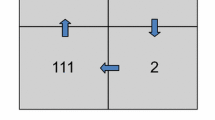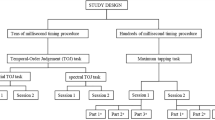Abstract
The Corsi Block Tapping Task is a widespread test used to assess spatial working memory. Previous research hypothesized that the discrepancy found in some cases between the traditional and the digital (touchscreen) version of the Corsi block tapping task may be due to a direct motor resonance between the experimenter’s and the participant’s hand movements. However, we hypothesize that this discrepancy might be due to extra movement-related information included in the traditional version, lacking in the digital one. We investigated the effects of such task-irrelevant information using eCorsi, a touchscreen version of the task. In Experiment 1, we manipulate timing in sequence presentation, creating three conditions. In the Congruent condition, the inter-stimulus intervals reflected the physical distance in which the stimuli were spatially placed: The longer the spatial distance, the longer the temporal interval. In the Incongruent condition the timing changed randomly. Finally, in the Isochronous condition every stimulus appeared after a fixed interval, independently from its spatial position. The results showed a performance enhancement in the Congruent condition, suggesting an incidental spatio-temporal binding. In Experiment 2, we added straight lines between each location in the sequences: In the Trajectories condition participants saw trajectories from one spatial position to the other during sequence presentation, while a condition without such trajectories served as control. Results showed better performances in the Trajectories condition. We suggest that the timing and trajectories information play a significant role in the discrepancies found between the traditional and the touchscreen version of the Corsi Block Tapping Task, without the necessity of explanations involving direct motor resonance (e.g. seeing an actual hand moving) as a causal factor.





Similar content being viewed by others
References
Berch, D. B., Krikorian, R., & Huha, E. M. (1998). The Corsi block-tapping task: Methodological and theoretical considerations. Brain and Cognition, 38, 317–338.
Brunetti, R., Del Gatto, C., & Delogu, F. (2014). eCorsi: Implementation and testing of the Corsi block-tapping task for digital tablets. Frontiers in Psychology, 5, 939.
Busch, R. M., Farell, K., Lisdhal-Medina, L., & Krikorian, R. (2005). Corsi block-tapping task performance as a function of path configuration. Journal of Clinical and Experimental Neuropsychology, 27, 127–134.
Casile, A., Dayan, E., Caggiano, V., Hendler, T., Flash, T., & Giese, M. A. (2010). Neuronal encoding of human kinematic invariants during action observation. Cerebral Cortex, 20, 1647–1655.
Casile, A., & Giese, M. A. (2005). Critical features for the recognition of biological motion. Journal of Vision, 5, 6.
Claessen, M. H., Van Der Ham, I. J., & Van Zandvoort, M. J. (2015). Computerization of the standard Corsi block-tapping task affects its underlying cognitive concepts: A pilot study. Applied Neuropsychology: Adult, 22, 180–188.
Corsi, P. M. (1972). Human memory and the medial temporal region of the brain. Unpublished doctoral dissertation, McGill University, Montreal, Canada.
Csibra, G. (2008). Action mirroring and action understanding: an alternative account. In: P. Haggard, Y. Rosetti, & M. Kawato (Eds.), Sensorimotor foundations of higher cognition. Attention and performance XXII (pp. 435–459). Oxford: Oxford University Press.
D’Ausilio, A., Brunetti, R., Delogu, F., Santonico, C., & Olivetti Belardinelli, M. (2010). How and when auditory action effects impair motor performance. Experimental Brain Research, 201, 323–330.
De Lillo, C. (2004). Imposing a structure on a Corsi-type task: Evidence for hierarchical organization based on spatial proximity in serial-spatial memory. Brain and Cognition, 55, 415–426.
Fecteau, S., Tormos, J. M., Gangitano, M., Théoret, H., & Pascual-Leone, A. (2010). Modulation of cortical motor outputs by the symbolic meaning of visual stimuli. European Journal of Neuroscience, 32(1), 172–177.
Fitts, P. M., & Deininger, R. L. (1954). SR compatibility: correspondence among paired elements within stimulus and response codes. Journal of Experimental Psychology, 48, 483.
Fitts, P. M., & Seeger, C. M. (1953). SR compatibility: spatial characteristics of stimulus and response codes. Journal of Experimental Psychology, 46, 199.
Hickok, G. (2009). Eight problems for the mirror neuron theory of action understanding in monkeys and humans. Journal of Cognitive Neuroscience, 21, 1229–1243.
Jacob, P., & Jeannerod, M. (2005). The motor theory of social cognition: a critique. Trends in Cognitive Sciences, 9(1), 21–25.
Johansson, G. (1973). Visual perception of biological motion and a model for its analysis. Perception and Psychophysics, 14, 201–211.
Kessels, R. P., van den Berg, E., Ruis, C., & Brands, A. M. (2008). The backward span of the Corsi block-tapping task and its association with the WAIS-III digit span. Assessment, 15, 426–434.
Kessels, R. P. C., van Zandvoort, M. J. E., Postma, A., Kappelle, L. J., & De haan, E. H. F. (2000). The Corsi block tapping task: Standardization and normative data. Applied Neuropsychology, 7, 252–258.
Kilner, J. M., & Lemon, R. N. (2013). What we know currently about mirror neurons. Current Biology, 23(23), R1057–R1062.
Kilner, J. M., Paulignan, Y., & Blakemore, S. J. (2003). An interference effect of observed biological movement on action. Current Biology, 13, 522–525.
Orsini, A., Pasquadibisceglie, M., & Picone, L. (2001). Factors which influence the difficulty of the spatial path in Corsi’s block tapping test. Perceptual and Motor Skills, 92, 732–738.
Parmentier, F. B. R., Andrés, P., Elford, G., & Jones, M. D. (2006). Organization of visuo-spatial serial memory: interaction of temporal order with spatial and temporal grouping. Psychological Research, 70, 200–217.
Parmentier, F. B. R., Elford, G., & Maybery, M. T. (2005). Transitional information in spatial serial memory: Path characteristics affect recall performance. Journal of Experimental Psychology. Learning, Memory, and Cognition, 31, 412–427.
Prinz, W. (1997). Perception and action planning. European Journal of Cognitive Psychology, 9, 129–154.
Rizzolatti, G., Fogassi, L., & Gallese, V. (2001). Neurophysiological mechanisms underlying the understanding and imitation of action. Nature Reviews Neuroscience, 2, 661–670.
Robinson, S. J., & Brewer, G. (2016). Performance on the traditional and the touch screen, tablet versions of the Corsi Block and the Tower of Hanoi tasks. Computers in Human Behavior, 60, 29–34.
Rossi-Arnaud, C., Pieroni, L., & Baddeley, A. (2006). Symmetry and binding in visuo-spatial working memory. Neuroscience, 139, 393–400.
Saygin, A. P. (2007). Superior temporal and premotor brain areas necessary for biological motion perception. Brain, 130, 2452–2461.
Smyth, M. M. (1996). Interference with rehearsal in spatial working memory in the absence of eye movements. The Quarterly Journal of Experimental Psychology: Section A, 49, 940–949.
Smyth, M. M., & Scholey, K. A. (1994). Interference in immediate spatial memory. Memory & Cognition, 22, 1–13.
Stürmer, B., Aschersleben, G., & Prinz, W. (2000). Correspondence effects with manual gestures and postures: a study of imitation. Journal of Experimental Psychology: Human Perception and Performance, 26, 1746.
Vandierendonck, A., Kemps, E., Fastame, M. C., & Szmalec, A. (2004). Working memory components of the Corsi blocks task. British Journal of Psychology, 95, 57–79.
Author information
Authors and Affiliations
Corresponding author
Ethics declarations
Conflict of interest
The authors declare that they have no conflict of interest.
Ethical approval
All procedures performed in this study involving human participants were in accordance with the ethical standards of the Università Europea di Roma Research Ethical Committee and with the 1964 Helsinki declaration and its later amendments.
Appendix 1
Appendix 1
Span sequences
The two sequences are taken, for the forward and backward versions, respectively, from the standardizations by Kessels et al. (2000, 2008). The locations were numbered as in Fig. 5.
Forward sequences | Backward sequences |
|---|---|
Length 2 | Length 2 |
4 7 | 8 5 |
2 9 | 6 4 |
Length 3 | Length 3 |
9 3 4 | 4 7 2 |
6 3 7 | 8 1 5 |
Length 4 | Length 4 |
1 5 2 8 | 3 4 1 7 |
7 4 3 9 | 6 1 5 8 |
Length 5 | Length 5 |
3 1 8 6 5 | 5 2 1 8 6 |
9 3 1 4 7 | 4 2 7 3 1 |
Length 6 | Length 6 |
2 8 3 5 6 4 | 3 9 2 4 8 7 |
5 3 1 2 8 9 | 3 7 8 2 9 4 |
Length 7 | Length 7 |
7 3 2 9 1 8 6 | 5 9 1 7 4 2 8 |
4 3 7 6 2 5 9 | 5 7 9 2 8 4 6 |
Length 8 | Length 8 |
1 9 6 3 5 4 2 8 | 5 8 1 9 2 6 4 7 |
2 9 4 6 1 7 3 5 | 5 9 3 6 7 2 4 3 |
Rights and permissions
About this article
Cite this article
Brunetti, R., Del Gatto, C., Cavallina, C. et al. Did I see your hand moving? The effect of movement-related information on the Corsi block tapping task. Psychological Research 82, 459–467 (2018). https://doi.org/10.1007/s00426-016-0834-6
Received:
Accepted:
Published:
Issue Date:
DOI: https://doi.org/10.1007/s00426-016-0834-6




